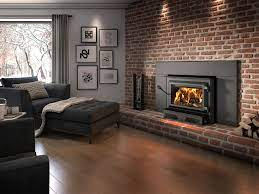More than one-third of American homes use a secondary heat source, with fireplaces being the most common. On the other hand, Wood-burning fireplaces have their own set of issues, including constant upkeep and maintenance, air pollution, and the risk of a house fire.
Because of these issues and the affordability and efficiency of propane and natural gas, more Americans are opting for safer and more environmentally friendly alternatives. While replacing an existing fireplace can be costly, installing a gas fireplace insert may be more straightforward and cost-effective. Read on to see if a gas fireplace insert is right for you if you want to convert your wood-burning fireplace to a gas-powered unit.
What Are Gas Fireplace Inserts and How Do They Work?
Inserts for gas fireplaces are gas-powered heating elements that fit inside a wood-burning fireplace. They produce flames similar to those produced by a best wood burning fireplace insert, but they are safer to use, more eco-friendly, and more efficient in terms of heat production than wood fires. Natural gas can be used, and the insert is connected to your home’s existing gas supply line.
Types of Gas Fireplace Inserts
Two types of gas fireplace inserts:
Direct-vent systems
Direct-vent systems are more expensive and less energy-efficient than indirect-vent systems. However, because the combustion gases are vented outdoors through a vent pipe, they are safer to use than ventless units.
Ventless systems
Although ventless systems are more cost-effective and energy-efficient, they run the risk of depleting indoor oxygen levels. As a result, even when equipped with oxygen depletion sensors that detect dangerous drops in indoor air quality, ventless systems are illegal in many states and jurisdictions.
Advantages and disadvantages of a Gas Fireplace Insert
Advantages
- It’s possible to put it in an existing fireplace.
- In comparison to constantly removing ash and cleaning your chimney once a year, it requires very little upkeep and maintenance.
- Creosote buildup does not pose a risk of chimney fires.
- Instead of building a wood fire, you can start one with the push of a button.
- It is not necessary to process, purchase, or store firewood.
- They’re more environmentally friendly and have 65 to 99 percent burning efficiency. On the other hand, Wood-burning fireplaces have a 15 to 30% efficiency rating.
Cons
- Gas inserts lack the ambiance of wood-burning fireplaces, such as the smell and sound of burning wood.
- Units can be costly.
- Because they are difficult and costly to install, you will almost certainly need to hire a contractor.
- Gas may be more expensive than wood, depending on the cost of firewood and gas in your area.
Before you buy a gas fireplace insert, here’s what you should know.
Determine the heat output your unit will require to heat your home, in addition to researching the cost. Depending on the power rating and extra features, gas fireplace inserts can cost anywhere from $400 to $3,500.
Furthermore, installation costs range from $400 to $3,000, depending on the difficulty of running gas, electrical, and ventilation lines and whether the unit is direct-vent or ventless. Because gas fireplace installation necessitates advanced skill and expertise, you should only attempt it if you have a lot of experience.
Multiply the square footage of the space you want to heat by the BTU requirements of your climate zone to determine the heat output the unit will require (measured in British Thermal Units or BTUs).
Zone 1 homes require 30 to 35 BTUs per square foot of space, Zone 2 homes require 35 to 40 BTUs, Zone 3 homes require 40 to 45 BTUs, Zone 4 homes require 45 to 50 BTUs, and Zone 5 homes require 50 to 60 BTUs. So, for a 300 square foot living room, you’ll need at least 9,000 BTUs if your home is in Zone 1 (300 x 30), 10,500 BTUs for Zone 2 (300 x 35), and so on.
Some people with smaller houses (400 to 1,000 square feet) may use their fireplace as their primary source of heat, though this is not common. If your insert is your primary heat source, you can use a similar calculation, but you’ll need to account for the height of your ceilings and how well your home’s envelope is sealed and insulated.
When determining the right heat output for your home, especially for the primary heat source, it’s always best to seek professional advice.
Additional Features
These features, in addition to your expectations for an insert’s role as a heat source, can give it added functionality:
- Instantly modify the heat output to your desired specifications with wall thermostats.
- To change the visual effect and heat output, adjust the height of the flame. Depending on the unit, you can modify the flame height from 30 to 100 percent flame production.
- Change the heat output and flame height from anywhere in the room using the remote control.
- Energy-saving timer with automatic shut-off.
- Smart fireplace inserts, which are less common, allow you to control the timer, heat, and flame outputs from a phone app rather than a wall-mounted display or hand-held remote.
- A blower to assist in the distribution of heat throughout the room.
- There are battery backups to keep the unit running in the event of a power outage.
- Use decorative log sets, glass chips, or stones for added aesthetic appeal.

